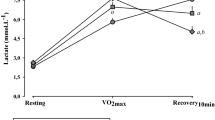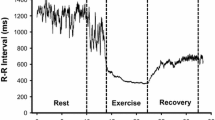Summary
Eighteen male volunteers (aged 20–23 years), not involved in any sporting activities, were submitted to 13 weeks of training consisting of 30 min exercise [at 50%–75% maximal oxygen intake\((\dot V_{O_2 \max } )]\) on a cycle ergometer, performed 3 times a week. Every 4 weeks cardiac function was evaluated by measuring the systolic time intervals at rest and during submaximal cycle exercise. Stroke volume (SV), heart rate (HR) and blood pressure (BP) responses to submaximal exercise,\(\dot V_{O_2 \max } \) and anaerobic threshold (AT) were also determined. Significant increases in\(\dot V_{O_2 \max } \), increases in AT and SV at the submaximal exercise intensities, as well as decreases in HR and BP were found after 4 weeks of training. Resting systolic time intervals were not affected by training, but during the submaximal cycle exercise the values of the pre-ejection period (PEP) and isovolumic contraction time (ICT) corresponding to HR of 100 beats·min−1 were significantly lowered after 13 weeks of training, whereas PEP, ICT and total electromechanical systole corresponding to HR of 130 beats·min−1 were significantly shortened by the 4th week. The ratios of PEP:LVET (left ventricular ejection time) and ICT:LVET during submaximal exercise were significantly lowered by training starting from the 8th week. These changes might be interpreted as evidence of the training-induced enhancement of the “contractility reserve”, i.e. the ability to increase heart muscle contractility with increasing exercise intensity.
Similar content being viewed by others
References
Abmed SS, Levinson GE, Schwartz CJ, Ettinger PD (1970) Comparison of systolic time intervals (STI) with direct measures of myocardial contractility in man. Clin Res 18:294
Aronow WS (1970) Isovolume contraction and left ventricular ejection times. Am J Cardiol 26:238
Bhan AK, Scheuer J (1975) Effects of physical training on cardiac myosin ATP-ase activity. Am J Physiol 228:1178–1182
Blomqvist CG, Saltin B (1983) Cardiovascular adaptations to physical training. Annu Rev Physiol 45:168–189
Brundin T, Cernigliaro C (1975) The effect of physical training on the sympathoadrenal response to exercise. Scand J Clin Lab Invest 35:525–530
Clausen JP (1977) Effect of physical training on cardiovascular adjustments to exercise in man. Physiol Rev 57:779–810
Dubiel JP, Kolasińska W (1980) Effect of one-year training on left ventricular contraction periods in female handball players (in Polish). Pol Tyg Lek 35:93
Dubiel JP, Kolasińska W, Ciochoń M (1975) The heart of long distance runners. Clin Res 23:180A
Dubiel JP, Kolasińska W, Ciochoń M (1977) Evaluation of left ventricular function at rest in women athletes participating in sports contests (in Polish). Pol Tyg Lek 32:2015
Dubiel JP, Kolasińska W, Ciochoń M (1979) Influence of physical exercise on left ventricular systolic time intervals of trained heart (in Polish). Pol Arch Med Wewn 61:273
Emmrich J (1956) Zur Frage der Klinischen Bedeutung einer Unterleitung der Anspannung des Linken Ventrikels in Umformungszeit und Druckanstiegszeit. Arch Kreislaufforsch 24:177
Franks BD, Cureton TK (1969) Effect of training on time components of the left ventricle. J Sports Med Phys Fitness 9:80
Georgetti C, Paolinelli G, Scarselli S, Cortoni A, Vitti V (1980) In: Lubich F, Venerando A (eds) Sports cardiology. Aulo Gaggi, Bologne
Jensen D (1971) Intrinsic cardiac rate regulation. Meredith, New York, pp 1–238
Jernerus R, Lundin G, Thompson D (1963) Cardiac output in healthy subjects determined with a CO2 rebreathing method. Acta Physiol Scand 59:390–399
Kolasińska W, Ciochoń M, Dubiel JP (1979) Left ventricular function of trained heart in a ten-minute period after submaximal effort (in Polish). Kardiol Pol 22:365
Markiewicz K, Cholewa M, Górski L, Gawor Z (1980) Effect of training on left ventricular contraction dynamics at rest and during maximal exercise. Acta Physiol Pol 31:593
McConahay DR (1972) Resting and exercise systolic time intervals. Circulation 46:633–634
Nutter DO, Priest RE, Fuller EO (1981) Endurance training in the rat. Myocardial mechanics and biochemistry. J Appl Physiol 51:934–940
Spodick DH, Kunnar S (1968) Isovolumetric contraction period of the left ventricle (results in normal series and comparison of methods calculation by atraumatic techniques). Am Heart J 76:498
Weissler AM (1972) Resting and exercise systolic time intervals. Circulation 46:633
Wiley JF (1971) Effect of 10 weeks of endurance training on left ventricular intervals. J Sports Med Phys Fitness 11:104
Williams JF Jr, Potter RD (1976) Effect of exercise conditioning on the intrinsic contractile state of cat myocardium. Circ Res 39:425–428
Winder WW, Hagberg JM, Hickson RC, Eshani AA, McLane JA (1978) Time course of sympathoadrenal adaptation to endurance exercise training in man. J Appl Physiol Respir Environ Exerc Physiol 45:370–374
Wyatt HL, Mitchell JH (1974) Influences of physical training on the hearts of dogs. Circ Res 35:883
Xenakis AP, Quarry VM, Spodick DH (1975) Immediate cardiac response to exercise: physiologic investigation by systolic time intervals at graded work loads. Am Heart J 89:178
Author information
Authors and Affiliations
Rights and permissions
About this article
Cite this article
Krzemiński, K., Niewiadomski, W. & Nazar, K. Dynamics of changes in the cardiovascular response to submaximal exercise during low-intensity endurance training with particular reference to the systolic time intervals. Europ. J. Appl. Physiol. 59, 377–384 (1989). https://doi.org/10.1007/BF02389814
Accepted:
Issue Date:
DOI: https://doi.org/10.1007/BF02389814




